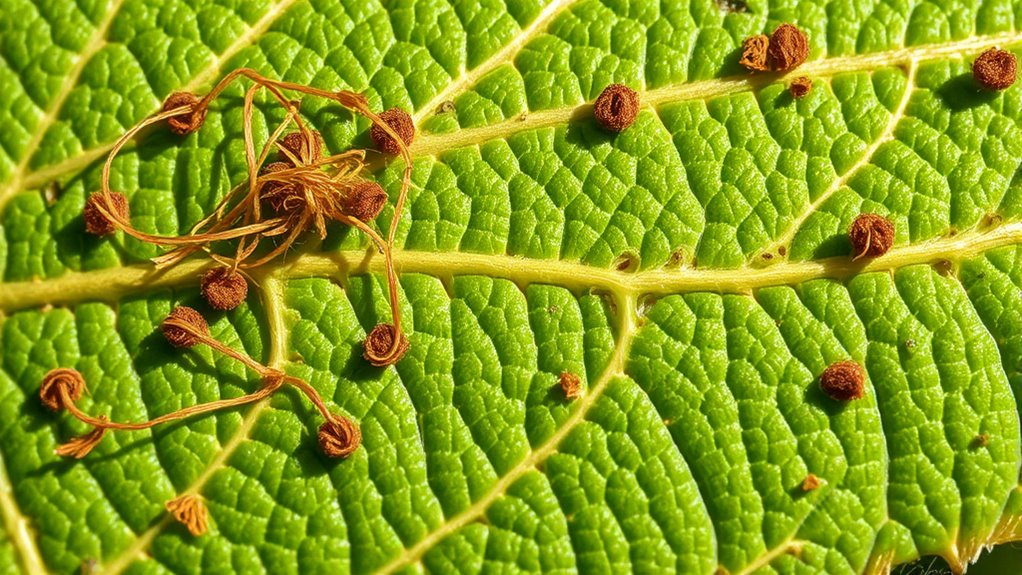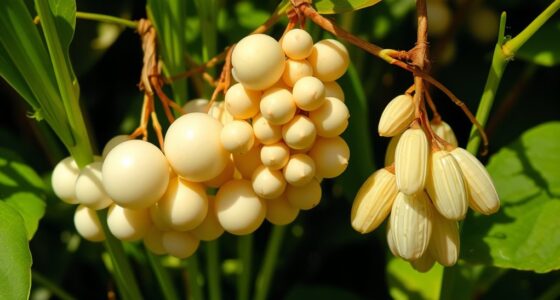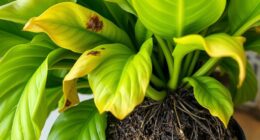To identify caterpillar species, look for specific clues like frass patterns, web structures, and chew marks. Tiny pellets or clustered frass can reveal feeding inside webs or hiding spots, while web shapes and silk density help indicate behaviors and species. Chew marks—ragged holes, skeletonized leaves, or serpentine tunnels—also provide hints. Combining these signs allows you to better understand what’s on your plants; explore further to recognize more detailed differences.
Key Takeaways
- Frass color, size, and pattern indicate specific caterpillar species and their developmental stages.
- Web shape, density, and placement reveal behaviors and habitat preferences of different caterpillar species.
- Chewing damage style and pattern help differentiate caterpillars based on feeding habits and group behavior.
- The combination of webbing, frass, and leaf damage provides clues for accurate pest identification.
- Monitoring these signs assists in understanding caterpillar species, their behavior, and effective pest management strategies.
Recognizing Frass and Its Significance
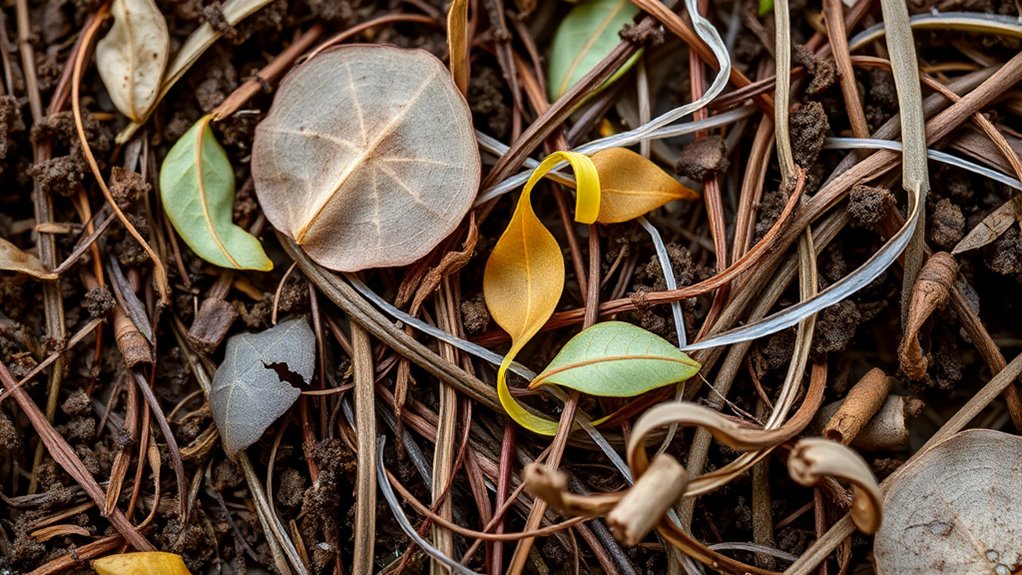
Have you ever noticed tiny pellets near caterpillar activity and wondered what they are? These small droppings, called frass, are a clear sign of a caterpillar’s presence. Recognizing frass helps you understand the caterpillar’s lifecycle stage and habits. Caterpillars often prefer specific host plants, and their frass patterns can indicate which plant they’re feeding on. For example, tightly clustered frass might suggest a caterpillar is feeding inside a protective web or hiding spot on a particular plant. Tracking frass can also reveal nearby caterpillar activity even if you don’t see the insect itself. By paying attention to these tiny pellets, you gain insight into their behavior, host plant preferences, and development stage, making it easier to identify and monitor caterpillars in your garden or natural area. Additionally, understanding art theory can deepen your appreciation of how natural patterns and behaviors are interpreted and represented in scientific observation and documentation.
Common Webbing Patterns and What They Indicate

Noticing the webbing patterns on plants or leaves can offer valuable clues about the presence and behavior of caterpillars and their associated species. Different webbing styles indicate various activities, like feeding or cocooning. For example, some caterpillars spin loose, irregular webs that suggest feeding sites, while others create tight, silk-enclosed clusters for protection. Webbing patterns also reveal silk production patterns, which help identify species and their cocooning behaviors. Keep an eye out for these signs:
- Dense, silk-covered leaf groups indicating caterpillar cocooning
- Irregular webbing suggesting feeding or resting sites
- Silken tunnels or tents used for protection or molting
Recognizing cocooning behaviors can provide insights into the caterpillar’s development stage and help determine the appropriate management approach.
Typical Chewing Damage and Its Origins
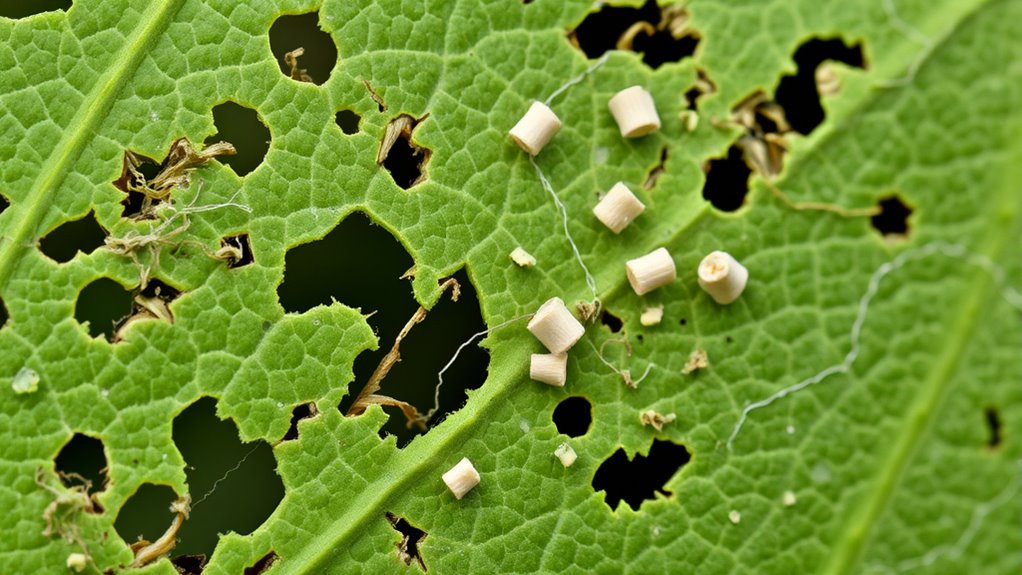
You’ll notice certain damage shapes and patterns that reveal which caterpillars are feeding on your plants. Webbing and frass (caterpillar droppings) can also provide clues about their origin. Recognizing these signs helps you understand the type of caterpillar responsible and how they’re affecting your garden. Additionally, observing self-watering plant pots can help maintain optimal moisture levels, which may influence caterpillar activity and plant resilience.
Damage Patterns and Shapes
What do the shapes and patterns of chewing damage reveal about the pests responsible? They can tell you a lot about the caterpillars in your urban landscaping and their natural predators. Chewing patterns are often specific to caterpillar species, helping you identify pests quickly. For example, ragged or irregular holes suggest leaf-chewing caterpillars, while skeletonized leaves indicate feeding that leaves veins intact. Recognizing these damage patterns can also help identify signs of conflict resolution skills and the level of active engagement of pests or their predators.
- Circular or uniform holes imply larvae feeding in groups or from a central point
- Tunnels or serpentine trails show internal feeding patterns
- Edges with jagged or uneven bites indicate aggressive chewers or multiple pests
Understanding these damage shapes helps you assess pest activity and consider natural predators to keep populations in check. Recognizing damage patterns is a vital step in integrated pest management.
Webbing and Frass Indicators
Webbing and frass are clear signs of caterpillar activity, revealing both the presence and behavior of pests. You’ll notice webbing where caterpillars hide or feed, often indicating a high population. Frass, or caterpillar droppings, accumulates beneath feeding sites, confirming ongoing activity. These indicators help you identify the species involved and assess the damage’s extent. Keep in mind, natural predators such as birds and parasitic insects are part of the ecosystem’s balance, often controlling caterpillar numbers. However, environmental impacts like pesticide use can harm these natural predators, leading to outbreaks. By recognizing webbing and frass, you can make informed decisions about pest management, minimizing ecological disruption while protecting your plants effectively. Additionally, understanding the role of contrast ratio in visual indicators can help in monitoring damage levels more accurately through detailed observation.
Distinctive Frass Types of Popular Caterpillars

You’ll notice that caterpillar frass varies in color, shape, and size, helping you identify different species. Some produce dark, pellet-like droppings, while others leave behind lighter, pellet-shaped fragments. Observing these differences can give you clues about the caterpillar’s identity and feeding habits. Recognizing the types of caterpillar frass can also indicate the stage of development or activity level of the caterpillar.
Frass Color Variations
Have you ever noticed how the frass—or caterpillar droppings—varies in color among different species? The frass color can provide important clues about the caterpillar’s identity and diet. For example, some species produce dark, almost black frass, while others leave behind pale or even greenish droppings. The frass color often correlates with what the caterpillar eats, such as dark leaves or bright flowers. Additionally, the webbing texture around the frass can hint at the caterpillar’s behavior and habitat. Keep an eye out for:
- Brightly colored frass indicating a diet rich in pigments
- Darker frass suggesting foliage with tannins or other compounds
- Consistent frass color paired with webbing texture for species identification
These variations help you distinguish species and understand their feeding habits more clearly. Recognizing caterpillar feeding behavior can further aid in identifying the species based on their frass and webbing patterns.
Frass Shape and Size
Frass shape and size offer valuable clues to identifying caterpillar species and understanding their habits. Smaller, pellet-like frass may indicate a caterpillar preparing for pupation, while larger, irregular droppings suggest active feeding. During caterpillar migration, frass is often scattered along their path, helping you track their movement. Noticing a shift in frass type can signal pupation signs, as caterpillars stop feeding and settle. Use this table to compare common frass types:
| Frass Shape | Size | Indicator |
|---|---|---|
| Pellet-like | Small | Feeding, migration |
| Irregular blobs | Medium | Active feeding |
| Fine powder | Tiny | Pupation approaching |
Recognizing these patterns aids in identifying species and predicting their next stage. Additionally, observing changes in frass can help determine the feeding habits and development stage of caterpillars.
Analyzing Web Structures for Species Identification

Analyzing web structures is an essential method for identifying spider species, as each species builds unique and characteristic webs. When examining caterpillar webs, you can gain insights into their ecology and larval behavior. These webs often reflect specific behaviors such as shelter-building, prey capture, or communication. Key features to observe include:
- Web shape and pattern: Orb webs, sheet webs, or irregular tangles indicate different species.
- Silk density and texture: Thick or sticky silk can suggest specialized prey capture strategies.
- Location and attachment points: Web placement reveals habitat preferences and feeding habits.
Additionally, understanding natural materials used in web construction can help differentiate species and their environmental adaptations.
Differentiating Chew Marks Among Caterpillar Groups

Understanding the differences in chew marks is essential for identifying caterpillar groups, as each species exhibits distinctive feeding patterns. Some caterpillars create jagged, irregular holes, while others leave smooth, evenly spaced bites. By observing these patterns, you can infer their larval habitat and migration habits. For example, species that migrate long distances often leave scattered, uneven chew marks, reflecting their movement across plants. Conversely, caterpillars that stay in a specific area tend to produce consistent, localized damage. Recognizing these subtle differences helps narrow down which group a caterpillar belongs to, especially when combined with knowledge of their preferred plants and behavior. Paying close attention to chew mark style and distribution can greatly improve your ability to identify caterpillar species accurately. Additionally, noting the webbing and frass patterns can provide further clues about their species and habits.
Combining Clues for Accurate Pest Identification
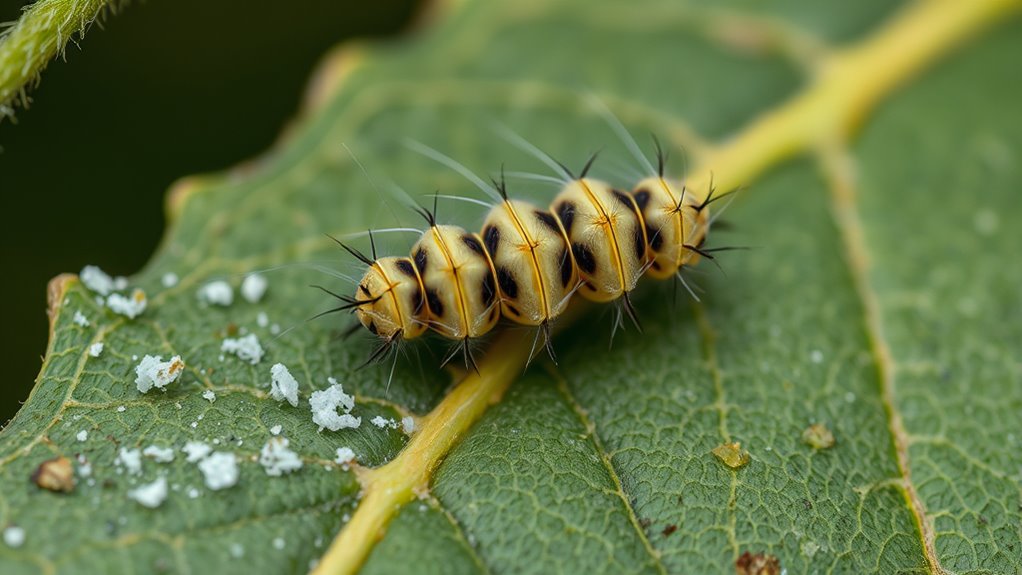
To accurately identify a pest, you need to combine multiple clues rather than relying on a single piece of evidence. Observing frass, webbing, chew patterns, and damage helps build an overall picture. Pay attention to how plant resistance influences pest behavior and damage patterns. Noting the presence of natural predators can also guide your identification—these beneficial insects often target specific caterpillars. Remember, combining clues is more reliable than focusing on one sign. Consider these key points:
- Frass type and placement
- Webbing and shelter structures
- Damage consistency with known pest behaviors
Case Studies: Common Caterpillar Damage Patterns

Examining real-world examples reveals how different caterpillars leave distinct damage patterns on plants. For instance, skeletonized leaves often indicate leaf-chewing caterpillars that evade plant defenses by feeding in specific areas, which can also influence predator interactions. Chewing patterns—such as irregular holes or margins—help identify species and show how they bypass plant defenses. Webbing and frass deposits can signal caterpillars that hide from predators within webs, reducing their chances of being eaten. Some caterpillars create distinctive chewing scars that alert you to their presence early, while others mimic plant parts to avoid predator interactions altogether. Recognizing these damage patterns allows you to better understand the strategies caterpillars use to survive, revealing insights into plant defense mechanisms and predator-prey dynamics.
Tips for Monitoring and Managing Caterpillar Infestations
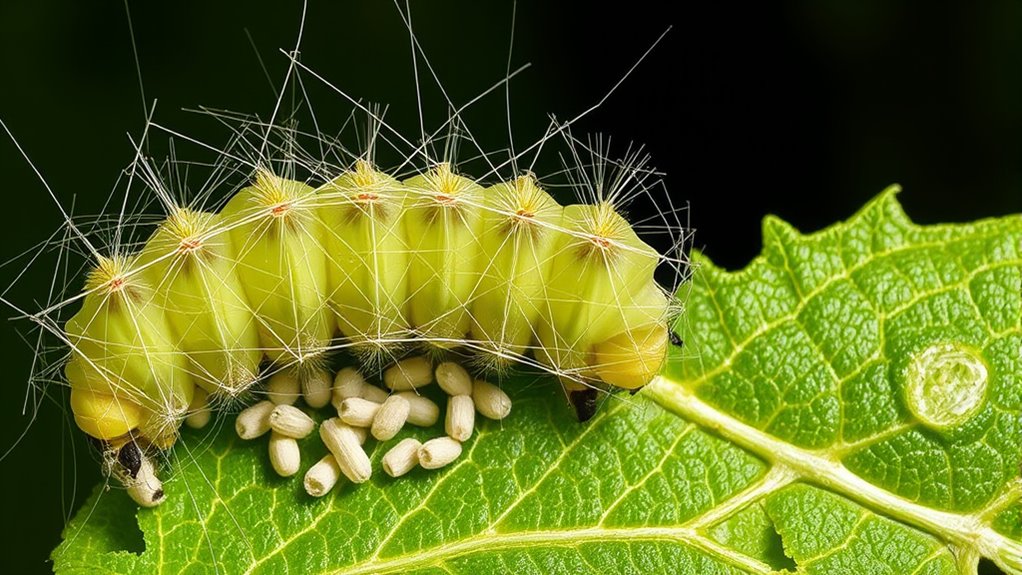
Regular monitoring is essential for early detection and effective management of caterpillar infestations. By regularly inspecting your plants, you can catch issues before they cause serious damage. Look for signs like webbing, chewed leaves, or frass. To manage infestations, consider integrating pest control methods such as manual removal or targeted insecticides. Natural predators, like birds and parasitic wasps, can help control caterpillar populations naturally. To maximize your efforts, keep in mind:
Regularly inspect your plants for signs of caterpillars and natural predators to maintain a healthy garden.
- Identify and encourage natural predators in your garden
- Regularly inspect plants for early signs of caterpillars
- Use pest control methods responsibly to avoid harming beneficial insects
Consistent monitoring combined with these strategies helps keep caterpillar numbers in check and promotes a healthy garden ecosystem.
Frequently Asked Questions
How Do Environmental Factors Influence Caterpillar Webbing and Damage Patterns?
Environmental factors, like microclimate effects, markedly influence how caterpillars create webbing and cause damage. Warmer, humid conditions encourage more webbing, providing shelter and affecting feeding patterns. Cooler or drier environments may reduce webbing and change damage types. Additionally, predator interactions shape caterpillar behavior; increased predation can lead caterpillars to hide more, altering webbing and feeding sites. You’ll notice these adaptations help caterpillars survive within their changing environments.
Can Frass Composition Reveal the Caterpillar’S Diet or Preferred Host Plant?
Imagine Sherlock Holmes examining frass at a crime scene; frass analysis can reveal your caterpillar’s diet and host plant clues. By studying frass composition, you identify specific plant materials ingested, helping you pinpoint their preferred host. This method provides valuable insights into caterpillar feeding habits, guiding effective control strategies and enhancing your understanding of their ecological relationships. Frass truly acts as a fingerprint of their dietary choices.
Are Certain Webbing Structures Unique to Specific Caterpillar Families?
You might notice that certain webbing structures are unique to specific caterpillar species, giving clues to their identification. These webbing patterns often show species specificity, as different caterpillars create distinct shelters or silk webs. By observing these webbing structures, you can often determine which species you’re dealing with, since each uses particular silk configurations suited to their behavior and environment. This makes webbing a useful indicator of caterpillar species.
What Are the Limitations of Using Chew Patterns Alone for Species Identification?
Think of relying solely on chew patterns for species ID like using a single brushstroke to identify an entire painting — it’s limited. Chew patterns can be similar across different caterpillars, leading to misidentification. You might mistake one species for another, missing key clues. So, don’t depend only on chew patterns; combine them with other signs to accurately identify caterpillar species and avoid costly mistakes.
How Do Seasonal Changes Affect Caterpillar Frass and Webbing Indicators?
Seasonal changes impact caterpillar behavior, affecting frass and webbing indicators. During seasonal migration, you might notice less webbing as caterpillars move to new areas. Nocturnal activity increases in cooler months, leading to more frass at night and less during the day. These seasonal shifts help you interpret caterpillar signs accurately, but remember, activity patterns vary with species and climate, so always consider local conditions when identifying caterpillar presence.
Conclusion
By paying close attention to frass, webbing, and chew patterns, you can confidently identify caterpillar species and prevent damage. Think of it as your own personal pest detective work—like Sherlock Holmes in the garden! Keep monitoring regularly, and you’ll stay one step ahead of these tiny invaders. With a keen eye and some patience, you’ll protect your plants and enjoy a thriving, pest-free oasis. Happy gardening!
